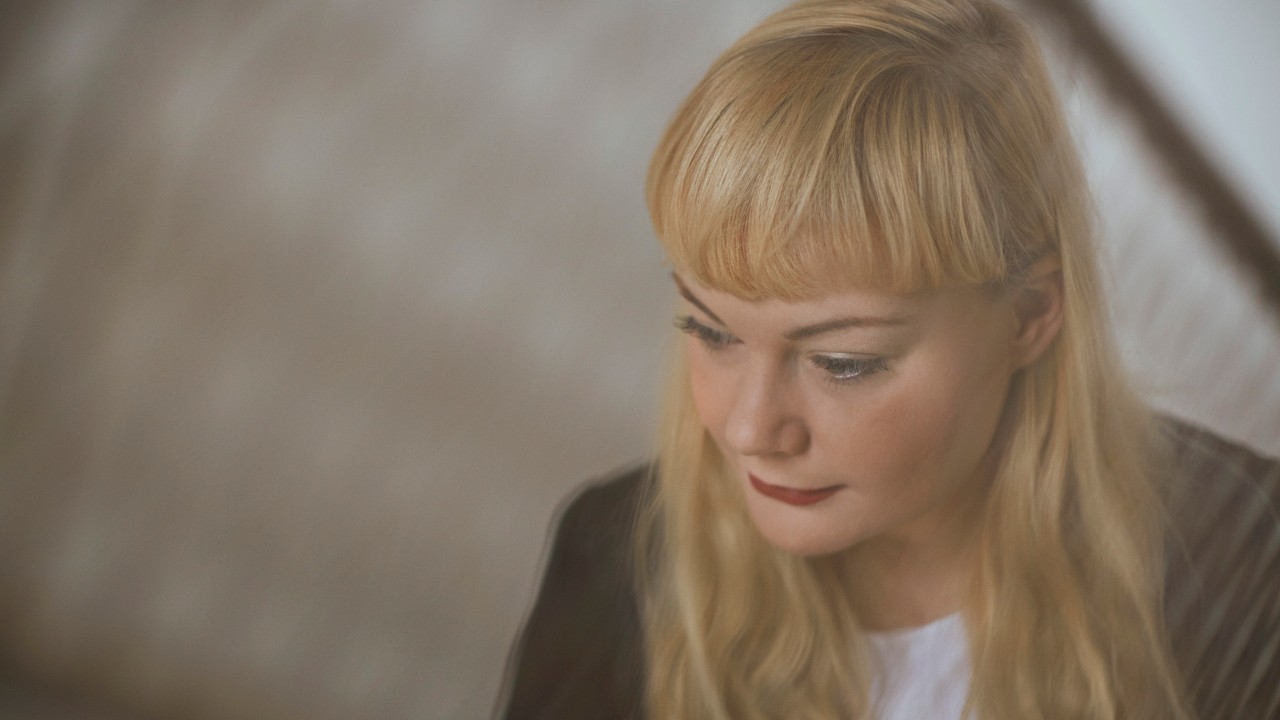

Maria Liv Kjærgaard
They’re Only Thoughts
Lost in a psychotic episode, Maria Liv Kjærgaard is consumed by fear. But there’s more to her than fear. The real Maria’s in there too – and she yearns to come out.
Maria Liv Kjærgaard
Denmark
23 years old. Is an only child.
Employment
Studying Public Administration.
Diagnosis
In 2014, Maria was diagnosed with paranoid schizophrenia, OCD and borderline personality disorder with self-harm urges.
A 4-year-old girl goes for a walk at the marina with her dad. They’ve just had some ice cream, and now they turn towards the water. The girl gets permission to walk along the edge of the wooden pier. On her one side, her father in his summer shorts; on the other, deep water. Now and then he lets go of her hand, to make her find her balance. Then he grabs hold again. The girl’s parents are divorced; she has looked forward to spending time with him, and he is laughing.
But his other hand grasps a beer, and the reason he’s laughing is that he’s drunk. His attention shifts to the passers-by, whom he greets in high spirits. The girl wants to hold his hand the entire time. The sun is shining. She wants to get away from the edge. Instead, Maria – for that is her name – fixes her gaze in front of her and focuses: she must not stumble.
Would they know?
Long before Maria was diagnosed with paranoid schizophrenia, the world flooded her senses with information. It tended to blur into a single message: Danger – beware! As a teenager, Maria kept a watchful eye on everything around her. She’d observe the tidy homes her classmates lived in; how they all had rooms of their own. Their dresser drawers were full of clothes that fit, and when they sat down to dinner, everyone spoke freely. Thoughts raced in Maria’s head when she visited. Her clothes were scruffy and too small. Would they notice? If a grownup became aware of her and asked her something, would she know the right answer? Maria cowered. When spoken to, she replied in monosyllables, and she lied if anyone asked what her mother did.
Maria knew a great deal about the lives of ordinary people. Yet they knew almost nothing of hers – and that was how she wanted it. The door to Maria’s world was shut, and she was on constant guard to make sure it didn’t slide open. For Maria’s ears had heard words that her girlfriends never had. They must have sat on couches next to their mothers, but none of them had sat on one and heard her mother say, “Your dad. He’s dead,” and learned he was dead because he’d hanged himself.
Maria does not remember reacting to the news. She’d been 12 that afternoon on the couch, and afterwards her mother, Mette, plunged into mental darkness; she lost her job, lost her acquaintances, fell deeper and deeper – but she still had Maria, and Maria tried to pull her back up. When Maria came home from school, her mother would be sitting in the corner of the couch, exactly where Maria had left her, her vest stained with cigarette ash and food. Sometimes Maria would resolve to give her a bath. But Mette was so heavy and listless, that every step of that task was difficult for Maria to manage.
“I wish someone had intervened before,” Maria’s mother says today. “I was very sick and unable to look after Maria. But I just couldn’t see it.” Days turned to months, and when at last Mette entered a psychiatric ward, a year and a half had vanished.
The fantasies flared up
Inside Maria’s head, there floats a memory from when she was 16 and spent a year living at a continuation school. She’d made a friend there, and both of them found boyfriends. Four best friends. One day they chased each other with water pistols and got soaked, squealing and sliding around in soapy water and pushing each other under the showers to get each other even wetter. It took days to clean everything up. That water fight stands out in Maria’s mind; a time when her head still was clear. There was only joy, she remembers. And the memory of that joy continues to gleam.
Back home again, she entered secondary school. Everything went well. Then it alternated between going all right and going badly. Then it got worse and worse. She began to imagine vile things, and the fantasies flared up; she had to fight them so they wouldn’t become reality. In the end, it was Maria who huddled in a corner of the couch, shaking, and after four years, Maria who entered a psychiatric ward.
She had felt so alone. At the hospital there were others like her, and people who understood. Maria recalls a day when she was sitting in the courtyard, trying to distract her obsessive thoughts by rocking back and forth. A nurse was seated beside her. Maria longed to confide in her, and the nurse remained sitting there. Then the thoughts poured out. Maria was terrified of turning into someone who tortured animals. Into a murderer. Into a pyromaniac who set fire to houses and took pleasure in seeing the flames consume everything. She was scared she was transforming into something inhuman. “Maria?” said the nurse. Maria could feel her stroking her cheek. “They’re only thoughts.”
Maria was diagnosed. She began taking medicine and was discharged to a group home for young adults with mental illness. It would turn out all right.
But when the terrors come, she says, it’s like a fire burning her skin. And the terrors came often. When she resumed her studies, her curling iron wanted to burn the house down. When she bought cigarettes, the petrol station threatened to explode. An evil man lurked in the laundry room of the group home. Maria hid in her room and drew the blinds, and at night she peed in a cup so she wouldn’t have to leave.
Once again, she was admitted to the hospital.
She called him uncle Jan
A psychiatric ward is a miniature society, home to a wide variety of people. As Maria describes it, the ward’s a place that is both safe and unsafe. During her second stay there, she met a CEO who’d been fired and lost everything, a prostitute who abused drugs and suffered from PTSD, and a little woman in her sixties who eyed her with malice, because she was sure Maria had stolen her husband. She also met a young girl with the same diagnosis she had, and a male alcoholic by the name of Jan.
Inside Maria’s head, a certain scene replayed itself in an endless loop. An evil man would leap upon her and slash her throat. They’re only thoughts, Maria repeated to herself each day, recalling the nurse’s words; only thoughts. But then one day on the ward, her delusion stepped into the TV room, a delusion of flesh and blood who struck Maria hard in the groin and screeched, “I’ll slit your throat!”
Her groin hurt. This was no fantasy.
It wasn’t a man who’d hit her. It was the suspicious little woman, and now the staff came running. But would they be there to protect Maria at night? Would the woman sneak into her room and murder her while she slept? Maria lay there, wide awake, and had to have more sleeping pills.
Months passed. The obsessive thoughts persisted, but Maria found more and more room to be herself. The young woman her age was sobbing, and Maria sat down beside her to comfort her. “It’ll be all right,” she told her, and the young woman calmed down. For hours she would play cards with Jan, who was nothing like the men in her fantasies. She called him Uncle Jan. He was completely convinced there was hope for Maria, and he said so often. “This is all just something that’s happening now,” he assured her.
The little woman emerged from her psychosis and asked Maria to forgive her. And Maria was released to the group home – and to a special early-intervention treatment for young adults with schizophrenia. That’s where she is now.
Her senses remain wide open
She’s discovered new sources of strength in herself. No more feeling ashamed. She writes opinion pieces and talks on the radio about being mentally ill. And as part of a national anti-stigma campaign, she serves as an ambassador for young people with mental illness. Recently, she received a letter from a girl asking for advice, and it filled her with unaccustomed joy.
Yet her senses remain wide open. A trip down Nørrebro Street and the smell of kebab and exhaust assaults her, the yellow of a sign glares in her eyes, a bustling and clattering comes at her from all directions. And if someone speaks to her, she hears the soft sound of tongue striking palate.
And then there are the obsessive thoughts. They insist, for instance, that her mother smoke precisely the same way that Maria does, with the same puffing sound. Maria wishes she could talk more about these thoughts, but it’s too dangerous. Mette puffs her smoke out just the way Maria needs her to. They are often together; the two of them do word games, play cards, recite rhymes to distract Maria’s thoughts. Every day they text each other good morning and good night.
The purpose of Maria’s therapy is to help her maintain her balance. She’s resumed her studies once more, and soon she will start prepping for the next exam. People are reaching out to her, and she’s reaching out to them. “Is it possible to become your friend, Maria?”
“Yes, of course! I’m very social.”
“You can be someone else’s friend – but can they be yours?”
Pause.
“There’s always a part of me that’s suspicious, I guess.” She hesitates. “Most people are probably just friends with the surface Maria.” But she explains that once in a while, the person she calls the real Maria emerges. “I do have people I trust.”
“Once in a while, Uncle Jan is right.”
